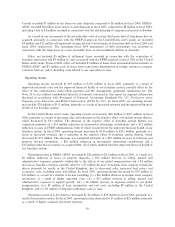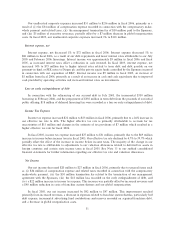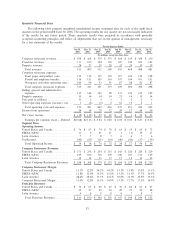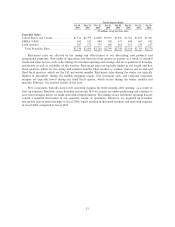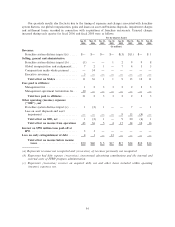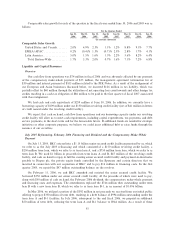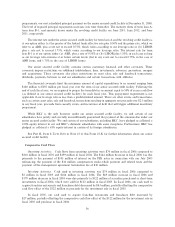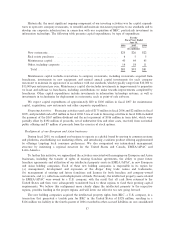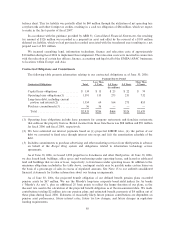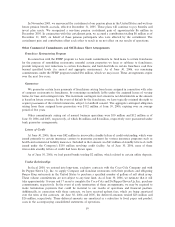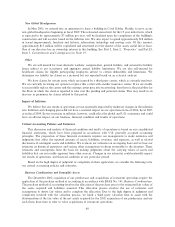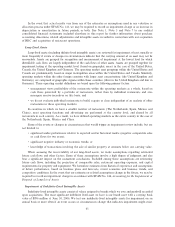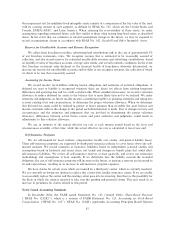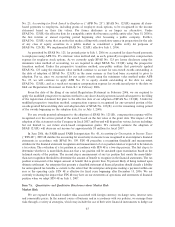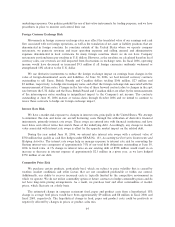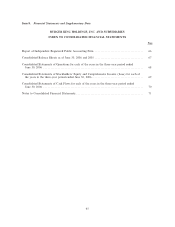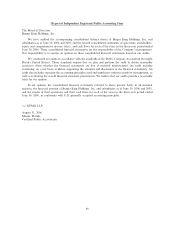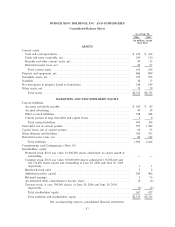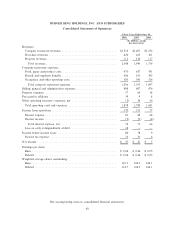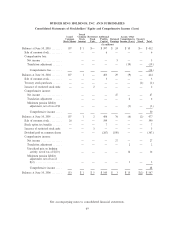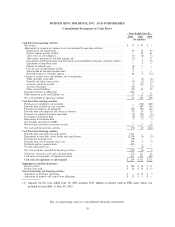Burger King 2006 Annual Report Download - page 72
Download and view the complete annual report
Please find page 72 of the 2006 Burger King annual report below. You can navigate through the pages in the report by either clicking on the pages listed below, or by using the keyword search tool below to find specific information within the annual report.New Global Headquarters
In May 2005, we entered into an agreement to lease a building in Coral Gables, Florida, to serve as our
new global headquarters beginning in fiscal 2009. The estimated annual rent for the 15 year initial term, which
is expected to be approximately $7 million per year, will be finalized upon the completion of the building's
construction and will escalate based on the inflation rate. We also expect to spend approximately $18 million
in tenant improvements, furniture and fixtures, information technology and moving costs. Of this amount,
approximately $15 million will be capitalized and amortized over the shorter of the assets useful life or lease.
One of our directors has an ownership interest in this building. See Part I, Item 2, ""Properties'' and Part II,
Item 5, Commitments and Contingencies in Note 19.
Other
We are self-insured for most domestic workers' compensation, general liability, and automotive liability
losses subject to per occurrence and aggregate annual liability limitations. We are also self-insured for
healthcare claims for eligible participating employees subject to certain deductibles and limitations. We
determine our liability for claims on a incurred but not reported based on an actuarial analysis.
We have claims for certain years which are insured by a third party carrier, which is currently insolvent.
We are currently reviewing our options to replace this carrier with another insurance carrier. If we are unable
to successfully replace the carrier and the existing carrier goes into receivership, then there is the possibility for
the State in which the claim is reported to take over the pending and potential claims. This may result in an
increase in premiums for claims related to this period.
Impact of Inflation
We believe that our results of operations are not materially impacted by moderate changes in the inflation
rate. Inflation and changing prices did not have a material impact on our operations in fiscal 2006, fiscal 2005
or in fiscal 2004. Severe increases in inflation, however, could affect the global and U.S. economies and could
have an adverse impact on our business, financial condition and results of operations.
Critical Accounting Policies and Estimates
This discussion and analysis of financial condition and results of operations is based on our consolidated
financial statements, which have been prepared in accordance with U.S. generally accepted accounting
principles. The preparation of these financial statements requires our management to make estimates and
judgments that affect the reported amounts of assets, liabilities, revenues, and expenses, as well as related
disclosures of contingent assets and liabilities. We evaluate our estimates on an ongoing basis and we base our
estimates on historical experience and various other assumptions we deem reasonable to the situation. These
estimates and assumptions form the basis for making judgments about the carrying values of assets and
liabilities that are not readily apparent from other sources. Changes in our estimates could materially impact
our results of operations and financial condition in any particular period.
Based on the high degree of judgment or complexity in their application, we consider the following to be
our critical accounting policies and estimates.
Business Combinations and Intangible Assets
The December 2002 acquisition of our predecessor and acquisitions of restaurant operations require the
application of the purchase method of accounting in accordance with SFAS No. 141, Business Combinations.
The purchase method of accounting involves the allocation of the purchase price to the estimated fair values of
the assets acquired and liabilities assumed. This allocation process involves the use of estimates and
assumptions to derive fair values and to complete the allocation. Due to the high degree of judgment and
complexity involved with the valuation process, we hired a third party valuation firm to assist with the
determination of the fair value of the net assets acquired for the 2002 acquisition of our predecessor and use
such firms from time to time to value acquisitions of restaurant operations.
60


